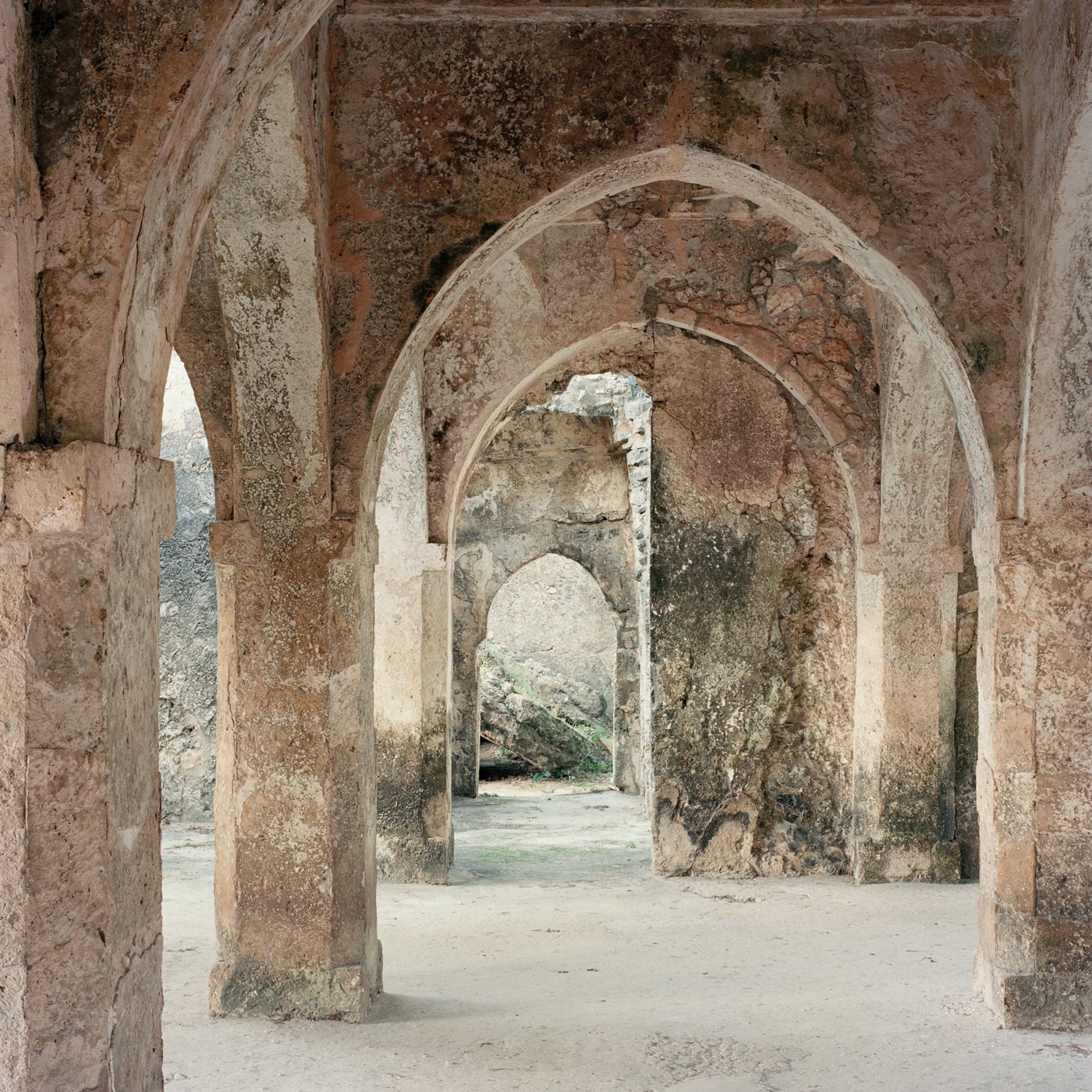
LagosPhoto Festival, 2025
“Kindred” group exhibition curated by Emmanuel Iduma and Ayọ̀bámi Adébáyọ̀ of Tender Photos.
Participating photographers: Tommie Ominde, Fua Bilich, Nipah Dennis, Katia Golovko, Robert Lyons, Oyewole Lawal, Hana Gamal, Aly Hazzaa, Fawaz Oyedeji, Christopher Littlewood, Yassine El Attar, Sauda Dhlabo, Adediran Adetutu, Adedolapo Boluwatife, Thero Makepe, Neo Baepi, Abderrahmane Ajja, Francis Ogunyemi, Ollie Walker, Rachel Seidu, Neema Ngelime, Catherine Li, Jean Luc Andrianasolo, and Omoregie Osakpolor.
At the LagosPhoto Festival, Tender Photos has curated Kindred, a constellation of 24 photographs and texts featured in the newsletter archive of Tender Photos. Showing an asynchronous cascade of images and blocks of text on adjacent walls, viewers are invited to match an image with its corresponding caption.
“Kindred” group exhibition curated by Emmanuel Iduma and Ayọ̀bámi Adébáyọ̀ of Tender Photos.
Participating photographers: Tommie Ominde, Fua Bilich, Nipah Dennis, Katia Golovko, Robert Lyons, Oyewole Lawal, Hana Gamal, Aly Hazzaa, Fawaz Oyedeji, Christopher Littlewood, Yassine El Attar, Sauda Dhlabo, Adediran Adetutu, Adedolapo Boluwatife, Thero Makepe, Neo Baepi, Abderrahmane Ajja, Francis Ogunyemi, Ollie Walker, Rachel Seidu, Neema Ngelime, Catherine Li, Jean Luc Andrianasolo, and Omoregie Osakpolor.
At the LagosPhoto Festival, Tender Photos has curated Kindred, a constellation of 24 photographs and texts featured in the newsletter archive of Tender Photos. Showing an asynchronous cascade of images and blocks of text on adjacent walls, viewers are invited to match an image with its corresponding caption.
Tender Photos’s “Kindred” series typically features a dual layer of images and commentary, where participants are invited to build on the platform’s growing archive by pairing a previously shared image with a new image of their choice. At LagosPhoto, the implication is that viewers can use the exhibited collection as a point of departure for drawing their own connections. The idea is also to highlight the “literature” involved in photography and the visual and spatial potentials of textuality. Embracing a fluidity and collectivity of language and authorship, the project integrates contemporary media and indigenous philosophy.
Launched in 2010, LagosPhoto is an international photography festival presented in Nigeria. In a month long festival, events include exhibitions, workshops, artist presentations, discussions and large scale outdoor prints displayed throughout the city with the aim of reclaiming public spaces and engaging the general public with multifaceted stories of Africa.
︎︎︎ Tender Photos at the LagosPhoto Festival
Launched in 2010, LagosPhoto is an international photography festival presented in Nigeria. In a month long festival, events include exhibitions, workshops, artist presentations, discussions and large scale outdoor prints displayed throughout the city with the aim of reclaiming public spaces and engaging the general public with multifaceted stories of Africa.
︎︎︎ Tender Photos at the LagosPhoto Festival
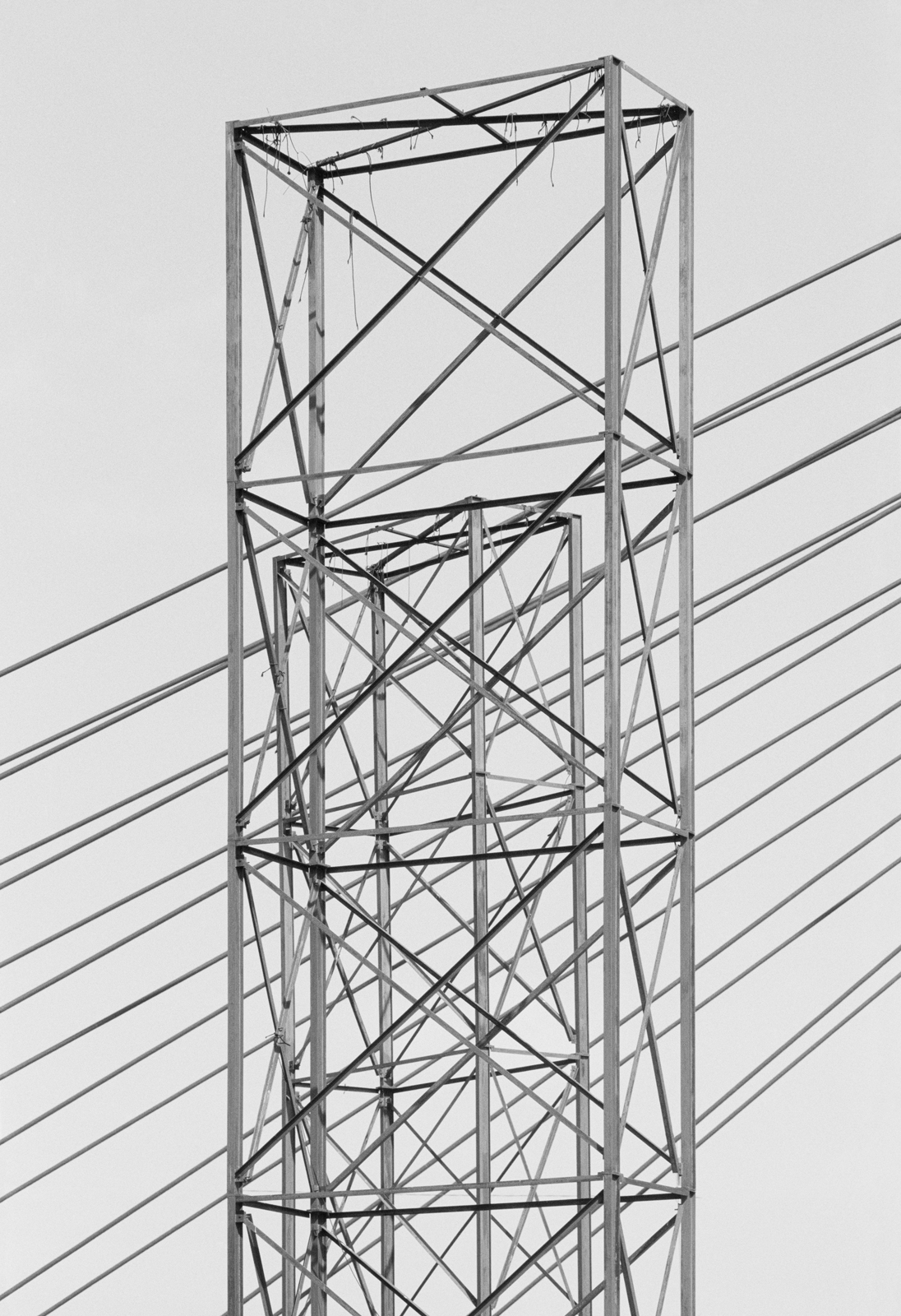
Photographic Exploration Project
DE-CONSTRUCTED
Group show at Loop – raum für aktuelle kunst, Berlin
August, 2025
Work from an ongoing series made in Johannesburg is included in De-Constructed, a collective exhibition as part of PEP (Photographic Exploration Project), curated by Bénédicte Blondeau. Through a series of thematic projects, PEP aims to explore the photographic language in all its aspects. For Blondeau, photography is a form of communication using visual elements as pieces of a particular vocabulary or “visual lexicon”. The aspect of collectivity is central to the project, resulting in a plurality of perspectives along the given theme.
DE-CONSTRUCTED
Group show at Loop – raum für aktuelle kunst, Berlin
August, 2025
Work from an ongoing series made in Johannesburg is included in De-Constructed, a collective exhibition as part of PEP (Photographic Exploration Project), curated by Bénédicte Blondeau. Through a series of thematic projects, PEP aims to explore the photographic language in all its aspects. For Blondeau, photography is a form of communication using visual elements as pieces of a particular vocabulary or “visual lexicon”. The aspect of collectivity is central to the project, resulting in a plurality of perspectives along the given theme.
“In an era marked by continuous change, where structures — social, personal, and visual — are constantly in flux, the selected works explore photography’s unique potential to question, dismantle, and reimagine reality.
The participating artists approach the theme from diverse perspectives. Some examine architectural and urban environments as spaces of transformation, while others turn to the shifting terrain of identity, familial ties, and societal or political structures — capturing moments of vulnerability, transition, and renewal. Experimental approaches push the boundaries of photographic form, mirroring the fragmentation of contemporary experience. Several works engage with questions rooted in the natural world and geological layers of the earth, exploring how physical landscapes too can be sites of deconstruction and historical sedimentation. Through acts of deconstruction and reinterpretation, these works invite viewers to reconsider the narratives and frameworks that shape our understanding of the world.”
︎︎︎ Photographic Exploration Project
︎︎︎ Bénédicte Blondeau
The participating artists approach the theme from diverse perspectives. Some examine architectural and urban environments as spaces of transformation, while others turn to the shifting terrain of identity, familial ties, and societal or political structures — capturing moments of vulnerability, transition, and renewal. Experimental approaches push the boundaries of photographic form, mirroring the fragmentation of contemporary experience. Several works engage with questions rooted in the natural world and geological layers of the earth, exploring how physical landscapes too can be sites of deconstruction and historical sedimentation. Through acts of deconstruction and reinterpretation, these works invite viewers to reconsider the narratives and frameworks that shape our understanding of the world.”
︎︎︎ Photographic Exploration Project
︎︎︎ Bénédicte Blondeau

“Why choose to take a photograph of an enfilade of archways? If the path leads anywhere the picture says little of what’s on the other end. Only that, without doubt, this pathway was built to allow passage. Hence it is at once a picture of the state of these archways as it is of a time now past. What might it seem like, then, to come to terms with the knowledge held in those cracks and blotches—to see through the multitude of feet for whom, as they approached this threshold, an elsewhere was possible?”
— Emmanuel Iduma, Tender Photo
— Emmanuel Iduma, Tender Photo
Every week the writer Emmanuel Iduma features one photograph and the photographer who took it in his African photography newsletter Tender Photo. Photographers are invited to respond to their image plus there’s a short introductory note from the editor. Emmanuel hopes to reach readers willing to give some thought to how photography impacts their lives and shapes their perceptions.
︎︎︎ Tender Photo
︎︎︎ Tender Photo

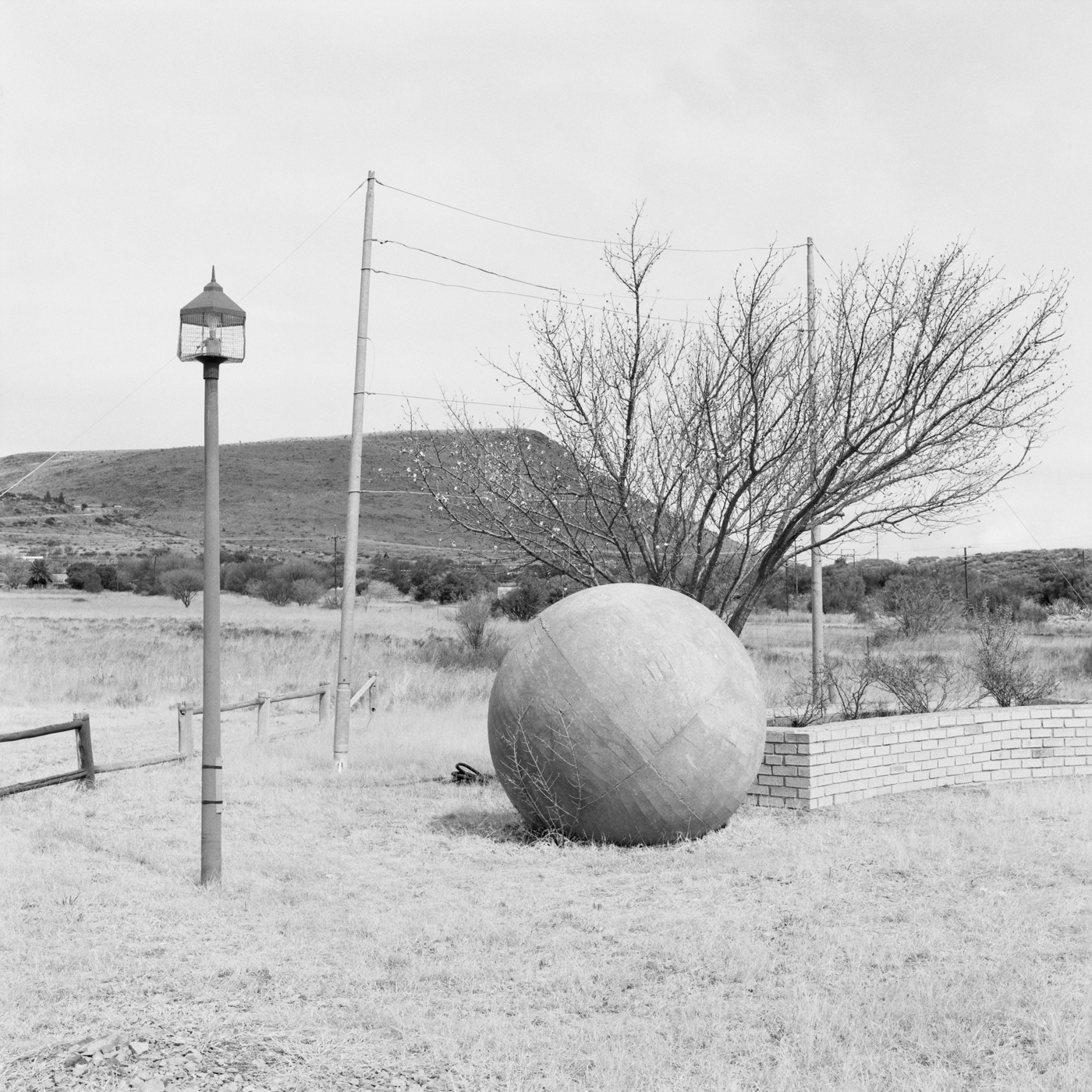


CAP Prize 2024, shortlist
The Contemporary African Photography Prize
A portfolio of 15 images from my Through Monuments project has been shortlisted for the CAP prize, which has been awarded annually since 2012 for works created on the African continent, or which engage with the African diaspora.
The Contemporary African Photography Prize
A portfolio of 15 images from my Through Monuments project has been shortlisted for the CAP prize, which has been awarded annually since 2012 for works created on the African continent, or which engage with the African diaspora.




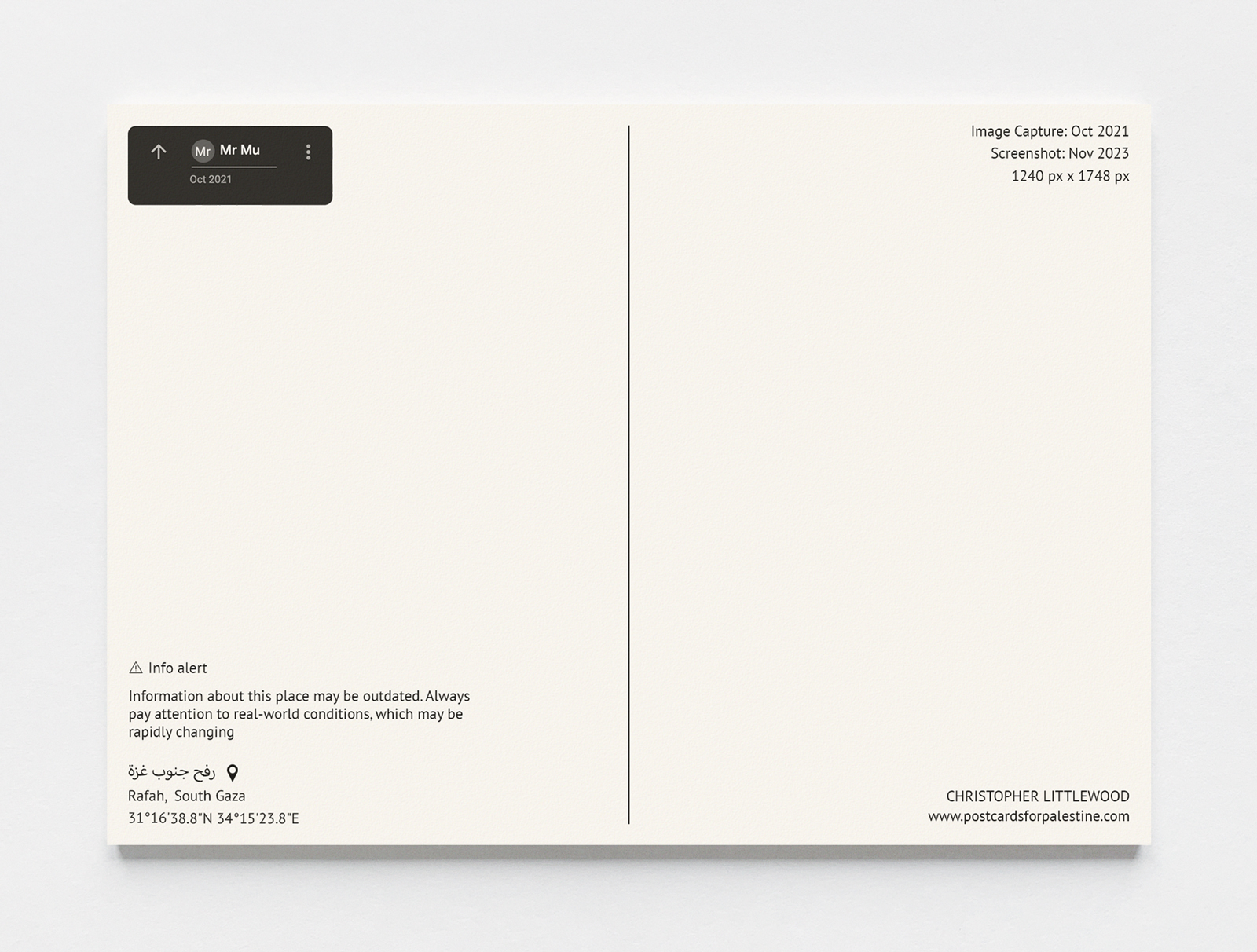



Postcards for Palestine
A set of screenshots sourced from 360° imagery uploaded to Google Maps from locations inside Gaza. Designed as postcards for the fundraising initiative Postcards for Palestine: a collective call to action aimed at providing support to the children and civilians affected by the devastating Gaza siege. Each image is accompanied by embedded data, such as the GPS coordinates and the name or alias of the original content creator.
While searching on Google Maps, I became interested in censored or erased information and how - through a lens of what is currently unfolding in the region - these glitches and digital artefacts evoke a sense of a territory and a people appearing to be wiped off the map. In a crisis-related message indicating the scale of destruction, the following warning appears alongside many of the locations:
! Info alert
Information about this place may be outdated. Always pay attention to real-world conditions, which may be rapidly changing
A set of screenshots sourced from 360° imagery uploaded to Google Maps from locations inside Gaza. Designed as postcards for the fundraising initiative Postcards for Palestine: a collective call to action aimed at providing support to the children and civilians affected by the devastating Gaza siege. Each image is accompanied by embedded data, such as the GPS coordinates and the name or alias of the original content creator.
While searching on Google Maps, I became interested in censored or erased information and how - through a lens of what is currently unfolding in the region - these glitches and digital artefacts evoke a sense of a territory and a people appearing to be wiped off the map. In a crisis-related message indicating the scale of destruction, the following warning appears alongside many of the locations:
! Info alert
Information about this place may be outdated. Always pay attention to real-world conditions, which may be rapidly changing
In a statement, the organisers of Postcards for Palestine have said "While we condemn the attacks by Hamas on October 7th 2023 in the strongest possible terms, we emphatically believe that the unprecedented bombardment of the Gaza Strip and the indiscriminate killing of thousands of innocent children and civilians is not the path to a solution – history did not begin on 7th October, and nor will it end when Gaza has been razed to the ground."
Set of 4 postcards
105 x 148mm
Pigment prints on bamboo paper
Set of 4 postcards
105 x 148mm
Pigment prints on bamboo paper

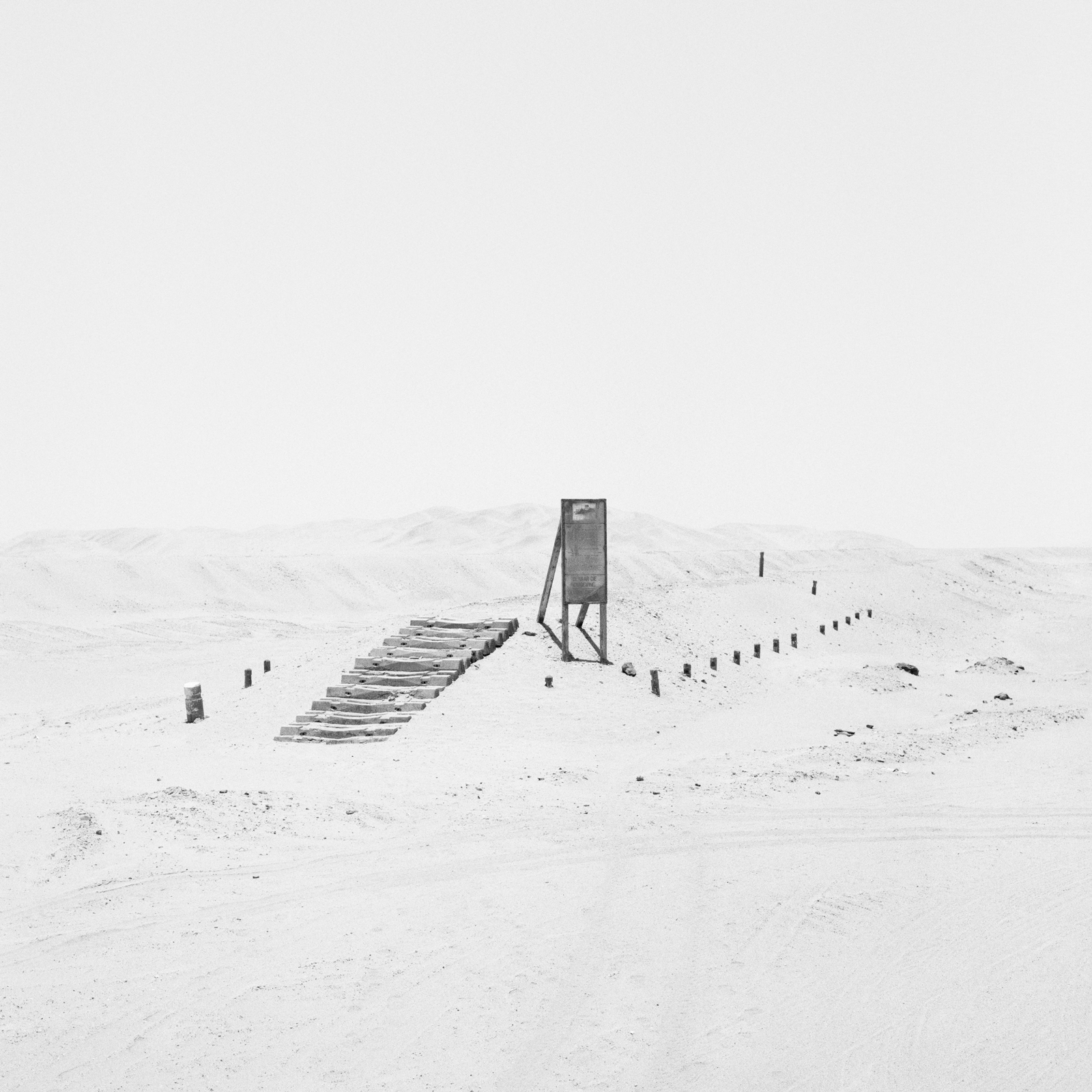
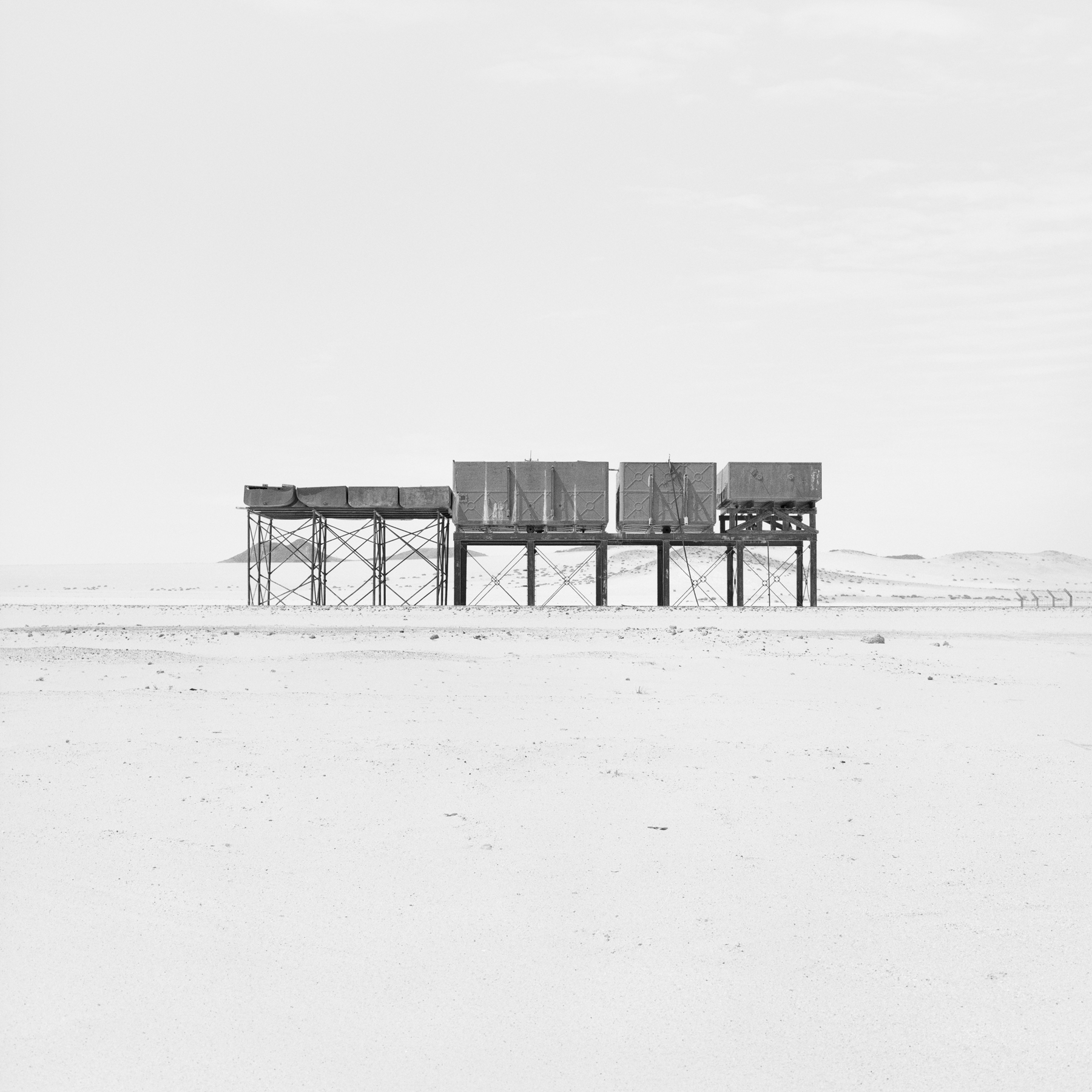

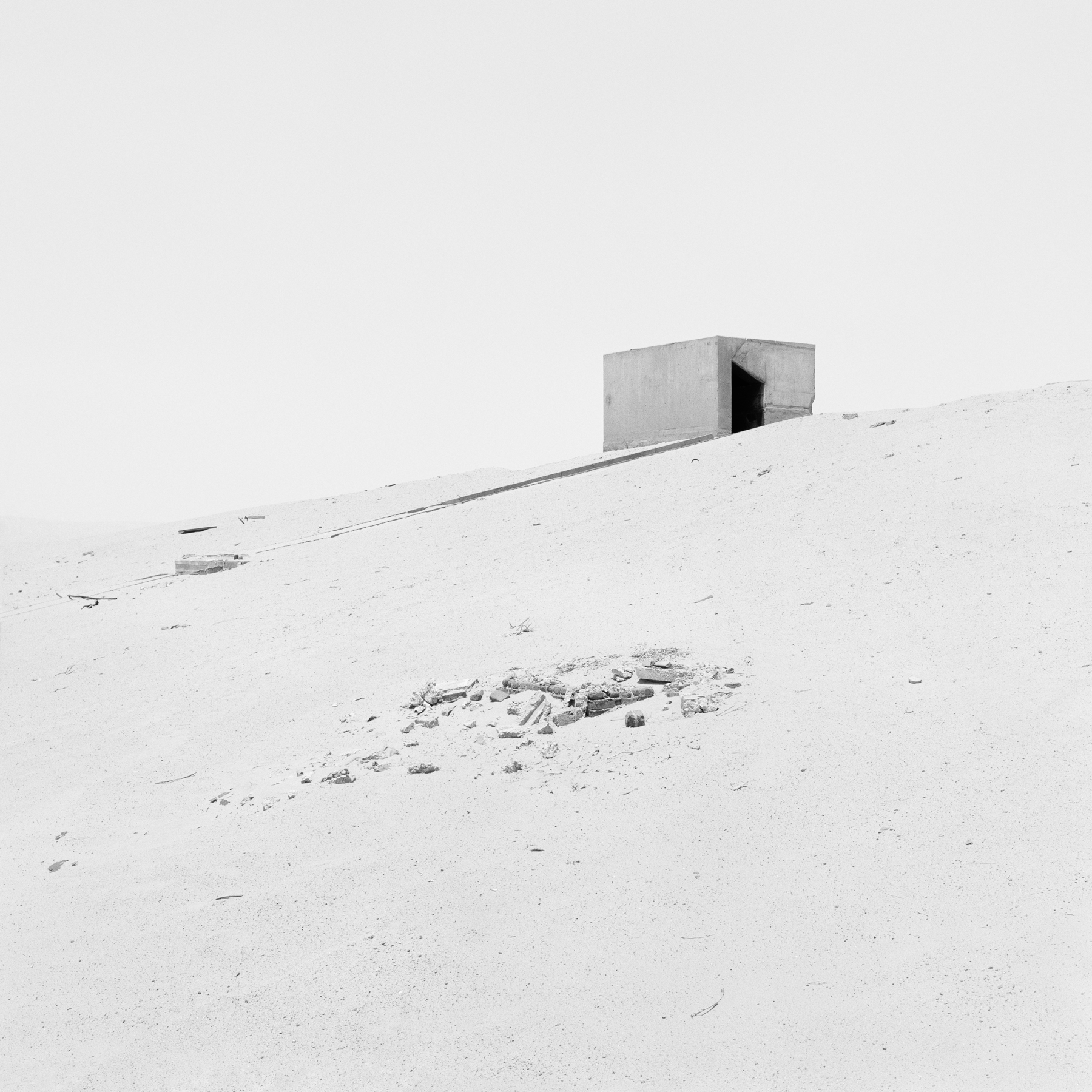

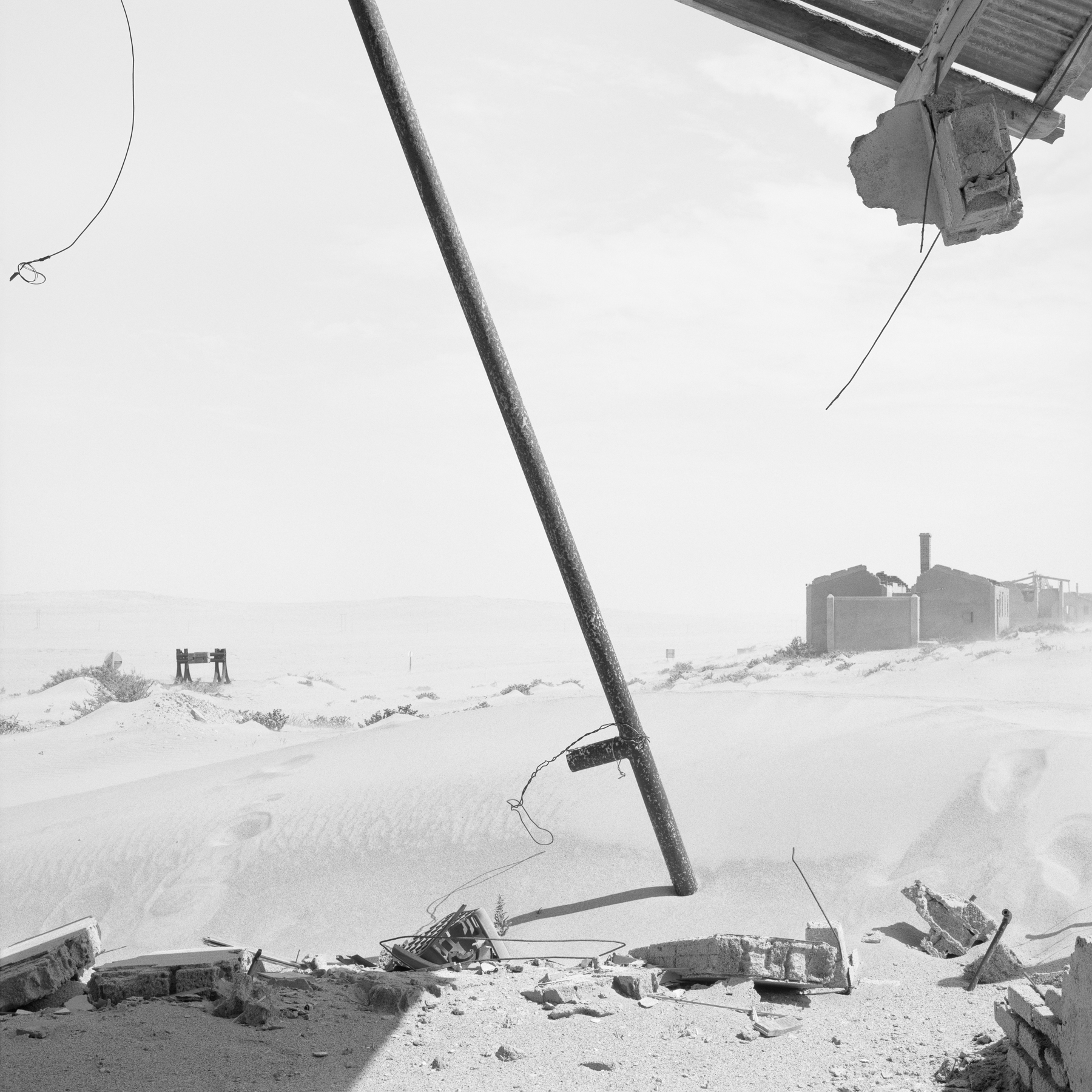





Hariban Award 2023, Honourable Mention
Through Monuments (Namibia)
Postcolonial Southern Africa is a place that enacts a continuous tension between its architectural constructions, its natural surroundings and the weight of racist historical ideologies. Through memorials, monuments, sites of cultural significance and other commemorative topologies, these photographs ruminate on these tensions within a contemporary Namibian context. Where in the drylands of this sparsely populated region, heritage sites are rendered indistinct by the shifting tides of dust and sandstorms.
Forming a subset within the broader Through Monuments project (2019-ongoing), which expands to include the entangled histories of South Africa, Namibia and Zimbabwe, the work explores how collective memory is expressed through overlapping material cultures. This chapter focuses on the railway lines that serviced diamond mining towns and military outposts, together with the area known as the Skeleton Coast, where shipwrecks, defunct oil rigs and other ruins lie strewn across the Namib Desert.
Sculptural interventions serve to disrupt a traditional narrative-based reading. Improvised and playful, these assemblages are simple exercises where found artefacts are underpropped, leaned against or hung. They evolved from the notion that memorialised heritage is undergoing a process of being redressed and transformed. Though humble on the surface, these artefacts are as inextricably linked to the material culture of European extractivism in Africa as any statue or structure. Perhaps as the importance of intangible heritage and oral histories challenge the role of monuments, it allows for physical structures and objects to undergo a process of being questioned, where material properties and design are potential subjects for artistic re-interpretation.
Through Monuments (Namibia)
Postcolonial Southern Africa is a place that enacts a continuous tension between its architectural constructions, its natural surroundings and the weight of racist historical ideologies. Through memorials, monuments, sites of cultural significance and other commemorative topologies, these photographs ruminate on these tensions within a contemporary Namibian context. Where in the drylands of this sparsely populated region, heritage sites are rendered indistinct by the shifting tides of dust and sandstorms.
Forming a subset within the broader Through Monuments project (2019-ongoing), which expands to include the entangled histories of South Africa, Namibia and Zimbabwe, the work explores how collective memory is expressed through overlapping material cultures. This chapter focuses on the railway lines that serviced diamond mining towns and military outposts, together with the area known as the Skeleton Coast, where shipwrecks, defunct oil rigs and other ruins lie strewn across the Namib Desert.
Sculptural interventions serve to disrupt a traditional narrative-based reading. Improvised and playful, these assemblages are simple exercises where found artefacts are underpropped, leaned against or hung. They evolved from the notion that memorialised heritage is undergoing a process of being redressed and transformed. Though humble on the surface, these artefacts are as inextricably linked to the material culture of European extractivism in Africa as any statue or structure. Perhaps as the importance of intangible heritage and oral histories challenge the role of monuments, it allows for physical structures and objects to undergo a process of being questioned, where material properties and design are potential subjects for artistic re-interpretation.
In the words of James Baldwin, "As we consider what role monuments play in our culture, it's the historical context, not the mythology, that we must remember." In that spirit, Through Monuments is not grouped following any chronological narrative. Instead, the photographs are sequenced according to the aesthetics of built form, material texture and decorative motif. Thereby encouraging the reading of monuments - not in terms of the events or personalities they purport to represent - but rather as a set of languages that reflect the context from which they emerged.
Presented by Benrido, the Hariban Award combines a 170-year-old analogue technique with contemporary photography. Glass plates have been used as the base for collotype printing plates which still continues today. The award is called “Hariban” as “Hari” means glass plate, and “ban” means printing plate in Japanese.
2023 Jury: Nestan Nijaradze, Rei Masuda, Awoiska van der Molan, Sarah Greene More info ︎︎︎ Hariban Award
Presented by Benrido, the Hariban Award combines a 170-year-old analogue technique with contemporary photography. Glass plates have been used as the base for collotype printing plates which still continues today. The award is called “Hariban” as “Hari” means glass plate, and “ban” means printing plate in Japanese.
2023 Jury: Nestan Nijaradze, Rei Masuda, Awoiska van der Molan, Sarah Greene More info ︎︎︎ Hariban Award